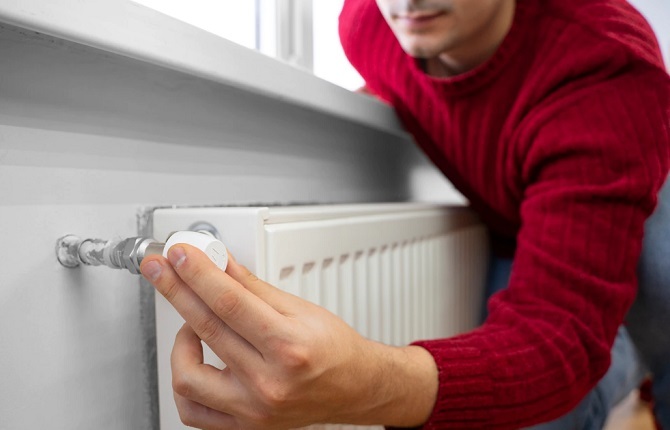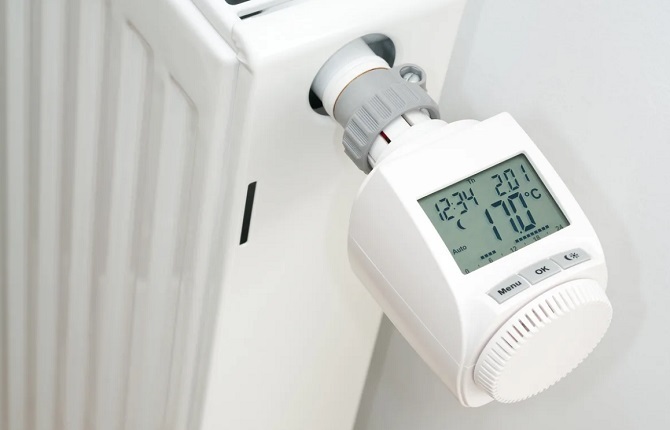
A thermostat for a heating radiator is a device that consists of a valve and a thermostatic mechanism. It is necessary to adjust and maintain a given level of heat in the room. If the heating battery is equipped with a thermostat, you can create your own comfortable microclimate in each room.
Other benefits:
- optimization of heating costs;
- disconnection of only one battery in case of emergency;
- no need to constantly monitor the operation of the sensor.
In this article, online hypermarket specialists DobroStroyexplain how thermostats work and how they differ.
The content of the article:
-
The principle of operation of thermostats
- Mechanical
- Electronic
- Installation Features
-
Heating controller installation
- The main stages of mounting the thermostat:
The principle of operation of thermostats
The principle of operation of the device depends on its type.
Mechanical
Mechanical thermostats are easy to operate, attractive at an affordable price. You can adjust the amount of coolant and heat transfer manually. The valve allows you to set the heating temperature with high accuracy.

The mechanical type thermostat consists of three elements: a regulator, an actuator and a bellows with liquid or gas. The substance inside plays an important role in the operation of the device. If the position of the lever changes, gas or liquid moves into the spool, adjusting the position of the stem. The latter partially blocks the passage and limits the ingress of coolant into the radiator.
Electronic
Such devices are of two types:
- Open. They can be programmed: you can set the response time of a certain mode. Such models are mainly used in industry.
- Closed. They are configured manually. You can adjust the temperature that will be maintained in the room, its allowable fluctuations in both directions.
The devices run on batteries or a special rechargeable battery that comes with the charger. They are equipped with a display showing the current temperature in the house. Electronic type thermostats are more complex than mechanical ones. They use a microprocessor and push-button control that allows you to set a certain temperature.

Shut-off valves are included in the thermostat kit. For example, the Valtec kit.

Set of thermostatic equipment Valtec for radiator, angled 1/2″
With it, you can shut off the water / steam supply to the system in order to repair or replace equipment. It also allows you to control the temperature in the room.
Installation Features
- Before installing any device, read the instructions from the manufacturer. If you have any doubts about the correct installation of the thermostat, it is better to entrust the work to professionals.
- There are fragile elements in the design of thermostats. During installation, be careful not to damage them.
- When installing, you need to know how the coolant circulates. There are arrows on the thermostat that indicate the direction of movement of the working medium.
- It is necessary to install the valve so that the thermostat is in a horizontal plane. Otherwise, hot air from the radiator will flow to the thermostat. This will negatively affect its operation and service life.
- If the thermostat is mounted on a system with one pipe, then bypasses must be installed under the pipes in advance. Otherwise, when the heating is turned off, all batteries will fail.
- Electronic models of devices should not be installed in the kitchen, near the boiler room or in the hall. It is better to mount them in corner rooms or areas with low temperatures. Electronic thermostats are more sensitive to external conditions.
- Near the thermostat should not be household appliances and devices that generate heat.
- It is not desirable that the device is exposed to direct ultraviolet rays or that it is in a draft.
Heating controller installation
Installing a thermostat is the last step in installing a heating system. It is recommended to place it at a distance of 40-60 cm from the floor. If the battery has a bottom coolant supply, you need to adjust the regulator to a lower temperature or install a remote sensor.

Thermostatic set for radiator straight in blister 1/2″ STM THERMO
The main stages of mounting the thermostat:
- Draining. Batteries must be drained of all liquid before installation. This can be done with a ball valve or shut-off valve. Then you need to open the radiator valve and turn off all the taps.
- Removing the adapter. The floor should be covered with napkins, towels or other materials that absorb moisture well. Use a wrench to unscrew the nuts that are on the pipe and adapter. Next, the adapter is unscrewed from the body.
- Installing a new adapter. It is necessary to place the adapter in the structure, tighten the nuts and the collar. After that, it is necessary to carefully clean the internal threads, remove the old collar and install a new one.
- Installation of a thermostat. Following the arrows drawn on the case, install the thermostat on the collar. Then, while fixing the valve with an adjustable wrench, tighten the nut between the valve and the regulator.
- Filling the radiator with water. Open the valve and fill the battery with liquid. So you can make sure that the system is functioning correctly and set the required temperature.
When choosing a suitable valve, be guided by the main parameters: maximum temperature, diameter of the inlet and outlet connections, working pressure.
If you need help, contact the consultants of the DobroStroy plumbing online store.
As an advertisement.


